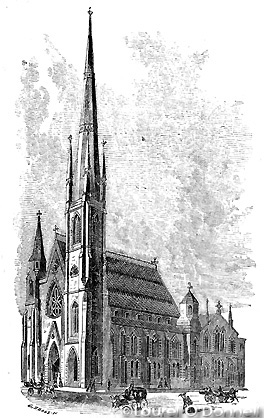|
|
Chapter IV
New York As It Is.
Churches of New York A. Description of the Island.—
B. Population at Different Periods.—
C. Streets and Avenues.—
D. Architecture of Manhattan—
E. Business in New York—
F. Churches of New York—
G. Parks and Squares.—
H. How New York is Supplied with Water.—
I. The Schools and Colleges of New York.—
J. Public Security—
K. New York All the Year Round—
L. The Libraries, Monuments and Markets of New York—
M. The Cemeteries of New York.
Baptist
Churches of New York—
Reformed Dutch—
Protestant Episcopal—
Lutheran—
Presbyterian—
Baptist—
Methodist—
Jewish—
Roman Catholic—
Other Denominations and Missionary Societies.
The first Baptists on Manhattan were of the Arminian faith. They began their toil amid violent persecution, and immersed some of their converts at midnight, to avoid difficulty. Their first house of worship, the Arminian Baptist church, stood on Golden Hill, afterwards Gold street, and was erected about 1725. The history of the Baptist church in New York presents some remarkable congregational feuds, and whether these have retarded or developed the growth of the denomination we shall not attempt to decide. As neither faction have understood the principle of surrender, nearly every serious dissension has either resulted in the extinction of a church, or in the founding of one or two new ones. In 1770 a difficulty arose in the First church, during the pastorate of Rev. John Gano, respecting psalmody. Most of the congregation preferred to abolish the old custom of parcelling out the lines in singing, whereupon a number of members withdrew and established the Second Baptist church. The Second church gained accessions after the Revolution, when another strife arose, about equally dividing the membership, each party claiming to be the Second Baptist church, and virtually excommunicating each other. Through the mediation of friends in 1791, the disputed title was dropped; one section became known as the Bethel church, and the other the Baptist church in Fayette street. Thus one church literally, though unhappily developed into three in twenty-one years. In 1802  The First Baptist Church—Cor. 39th Street and Park Avenue. Erected 1871; size 66 x 100 feet; cost, including lots, $250,000; seating capacity, 1,000. John Inglesby, a member of the Fayette street church, was licensed to preach, and the next year began to hold regular services in a hall in Greenwich street, which resulted at length in the First Ebenezer Baptist church. Inglesby's course was not approved by the Fayette-street society. His preaching savored of Antinomianism, and his society was refused admission into the Association. The Ebenezer church of our day was organized in 1825, and after several removals is now located in West Thirty-sixth street. The Welsh Baptist church was founded in 1807, the Mulberry street, the Abyssinian, and the North Beriah in 1809, the Zoar church in 1811, the South Baptist in 1822, the Cannon street in 1827, the North Baptist in 1828, the Salem in 1834, the West church in 1835, the Berean in 1838, the Sixth street in 1840, and the Bloomingdale in 1843. The Old and the New school, the Colored, the German, the Welsh, and the Free-will Baptists, united, have about fifty places of worship in New York at this time, and rank among the most zealous and useful of our city churches.
|
|
89
:: Previous Page :: Next Page ::
Books & articles appearing here are modified adaptations
from a private collection of vintage books & magazines. Reproduction of these pages is prohibited without written permission. © Laurel O’Donnell, 1996-2006.
|
|
